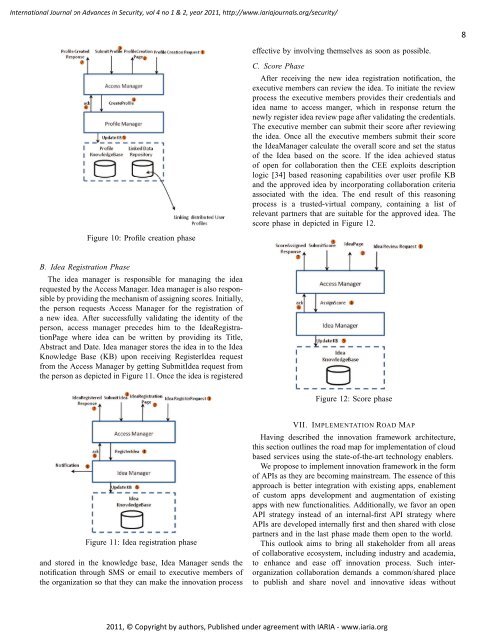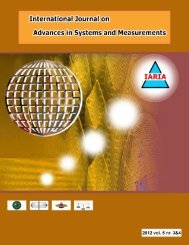Fault Tolerance Framework using Model-Based - IARIA Journals
Fault Tolerance Framework using Model-Based - IARIA Journals
Fault Tolerance Framework using Model-Based - IARIA Journals
Create successful ePaper yourself
Turn your PDF publications into a flip-book with our unique Google optimized e-Paper software.
International Journal on Advances in Security, vol 4 no 1 & 2, year 2011, http://www.iariajournals.org/security/<br />
B. Idea Registration Phase<br />
Figure 10: Profile creation phase<br />
The idea manager is responsible for managing the idea<br />
requested by the Access Manager. Idea manager is also responsible<br />
by providing the mechanism of assigning scores. Initially,<br />
the person requests Access Manager for the registration of<br />
a new idea. After successfully validating the identity of the<br />
person, access manager precedes him to the IdeaRegistrationPage<br />
where idea can be written by providing its Title,<br />
Abstract and Date. Idea manager stores the idea in to the Idea<br />
Knowledge Base (KB) upon receiving RegisterIdea request<br />
from the Access Manager by getting SubmitIdea request from<br />
the person as depicted in Figure 11. Once the idea is registered<br />
Figure 11: Idea registration phase<br />
and stored in the knowledge base, Idea Manager sends the<br />
notification through SMS or email to executive members of<br />
the organization so that they can make the innovation process<br />
effective by involving themselves as soon as possible.<br />
C. Score Phase<br />
After receiving the new idea registration notification, the<br />
executive members can review the idea. To initiate the review<br />
process the executive members provides their credentials and<br />
idea name to access manger, which in response return the<br />
newly register idea review page after validating the credentials.<br />
The executive member can submit their score after reviewing<br />
the idea. Once all the executive members submit their score<br />
the IdeaManager calculate the overall score and set the status<br />
of the Idea based on the score. If the idea achieved status<br />
of open for collaboration then the CEE exploits description<br />
logic [34] based reasoning capabilities over user profile KB<br />
and the approved idea by incorporating collaboration criteria<br />
associated with the idea. The end result of this reasoning<br />
process is a trusted-virtual company, containing a list of<br />
relevant partners that are suitable for the approved idea. The<br />
score phase in depicted in Figure 12.<br />
Figure 12: Score phase<br />
VII. IMPLEMENTATION ROAD MAP<br />
Having described the innovation framework architecture,<br />
this section outlines the road map for implementation of cloud<br />
based services <strong>using</strong> the state-of-the-art technology enablers.<br />
We propose to implement innovation framework in the form<br />
of APIs as they are becoming mainstream. The essence of this<br />
approach is better integration with existing apps, enablement<br />
of custom apps development and augmentation of existing<br />
apps with new functionalities. Additionally, we favor an open<br />
API strategy instead of an internal-first API strategy where<br />
APIs are developed internally first and then shared with close<br />
partners and in the last phase made them open to the world.<br />
This outlook aims to bring all stakeholder from all areas<br />
of collaborative ecosystem, including industry and academia,<br />
to enhance and ease off innovation process. Such interorganization<br />
collaboration demands a common/shared place<br />
to publish and share novel and innovative ideas without<br />
2011, © Copyright by authors, Published under agreement with <strong>IARIA</strong> - www.iaria.org<br />
8







